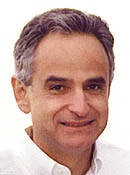

AfterWords
Dr. Padre
Medical school graduate leads a ‘major league’ team of physicians. By Jayne Denker
 |
The clubhouse of a Major League Baseball team apparently could often pinch hit as a family clinic when it comes to medicine.
While pennant-race-ending injuries to star players grab the headlines—and the hearts of fans—most medical issues are a little less noteworthy, says Jan Fronek ’78M (MD), head team physician for the San Diego Padres.
“Half of the medical problems are general medicine—upper respiratory infections; ear, nose, and throat issues; and communicable diseases,” says Fronek, who has been lead doctor for the National League West team since 1991.
In addition to tending to current Padres, the team of physicians—two other orthopedists and three internists—attend to ailing members of visiting teams, retired players, players who used to be with the Padres but have since left (“One player who was traded called from Japan for medical advice,” Fronek says), and current players’ families.
“It’s like a family clinic with no charge and no appointments,” he says.
Fronek, who also heads the sports medicine section of the Scripps Clinic in California, says he didn’t always have his sights set on being a team doctor for “star athletes”—or even plan on getting into sports medicine.
“I was interested in internal medicine,” he says. “But my next-to-last rotation in my fourth year at Rochester was in orthopedic surgery. That really opened my eyes to the field, and to its opportunities and challenges.”
After earning his M.D. at Rochester, he completed his residency at the University of California at San Diego, then moved on to a fellowship in sports medicine at the Hospital for Special Surgery in New York City.
Although he didn’t play baseball when he was young—growing up in Czechoslovakia, Fronek was more inclined to play soccer—his own athletic experience, especially being on the ski team at Rochester, helped him understand athletes’ perspectives and goals for recovery, which include getting back in the game as quickly as possible.
“Sometimes players cut corners to get playing again, and [physicians] can learn from that,” he says. “Developments in sports medicine come from professional players pushing themselves to see how fast they can recover.
“There are times that I’m aware of the additional pressure of taking care of some ‘high-profile’ individuals,” Fronek says. “But ultimately the goal is to provide good orthopedic care regardless of the patient’s salary or stature in the community.”
He tends to keep a low profile, in part because he’s modest about his position, and also because recent privacy laws, under the enforcement of the Health Insurance Portability and Accountability Act of 1996 (HIPAA), have put more distance between the team doctors and the media.
“HIPAA rules have restricted the team physicians’ discussion of the players’ injuries and problems,” Fronek says. “Now the team physician isn’t interviewed. You have the doctor-patient relationship, but the health status is a matter of public knowledge, and you have to share the information with the media, so the team sends out a press release with the key information.”
Not everything is so high-stakes, though. Fronek once had to stop a player from having too much fun with his dislocated shoulder. According to one newspaper’s account, general manager Kevin Towers said third baseman Sean Burroughs “was fooling around with [his shoulder], popping it in and out. Dr. Fronek told him not to do that.”
Then there was the player who reported a rash, but who was unusually reticent about allowing Fronek to check it out.
“I said I needed to see it and maybe call a dermatologist,” Fronek says. “He kept saying, ‘It’s got red bumps,’ and to just give him ‘that rash cream.’ He wouldn’t let me see it, wouldn’t let me see it. Then, finally, he said, ‘You can’t see it. It’s on the bottom of my two-month-old son.’”
1978
Mark Goldshein ’78M (MD) isn’t surprised that his classmate and housemate from the mid-70s has such a high-profile position.
“It takes something special to rise to the top of the sports medicine profession and become a Major League Baseball team doctor,” Goldshein says. “Jan has had wonderful success, and I think it’s based on the wonderful care he gives his patients.”
Goldshein also remembers Fronek’s optimism, sense of humor, and compassion.
“In our second year, we were sharing a house with several other students, one of whom became very sick. Jan was devastated—I think even more devastated than the sick student was.”
